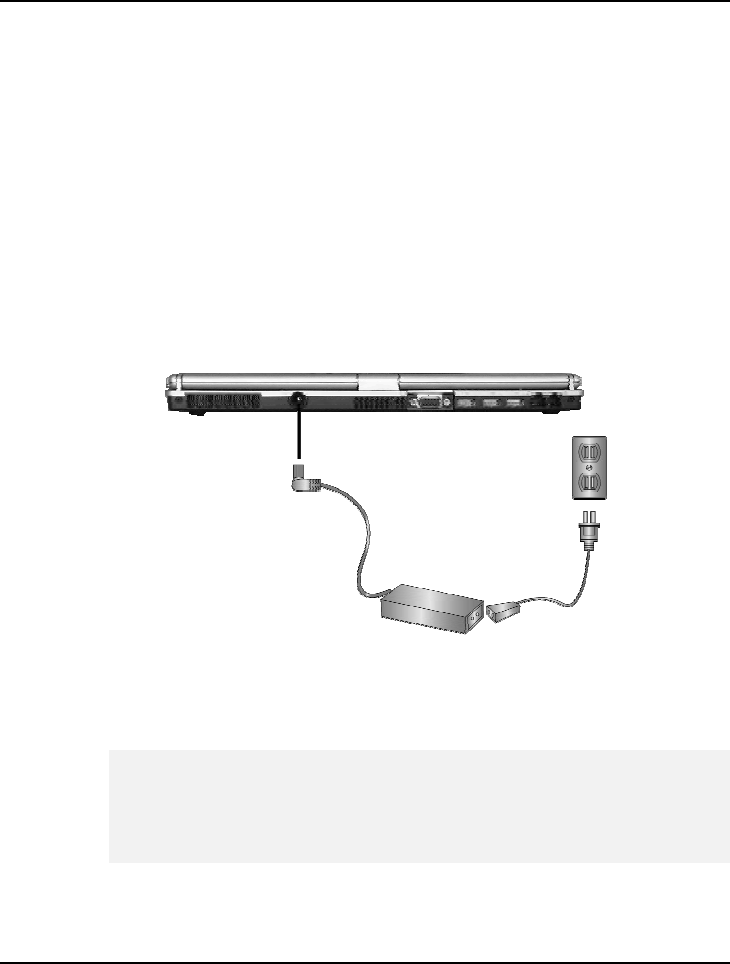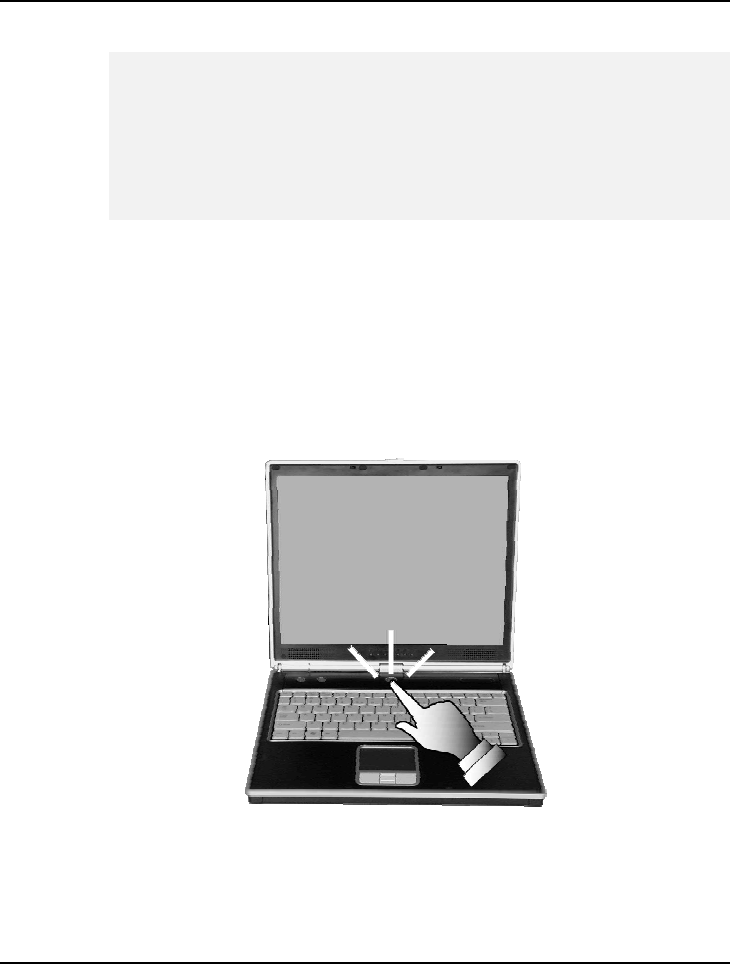First Computer MB02W3BB Notebook Computer With 802.11b WLAN Module User Manual 11b
First International Computer Inc Notebook Computer With 802.11b WLAN Module 11b
Contents
- 1. Page 1 to 30 of user manual
- 2. Page 31 to 42 of user manual
- 3. Page 43 to 60 of user manual
- 4. Pge 61 to 80 of user manual
- 5. Page 81 to 113 of user manual
Page 31 to 42 of user manual

Getting Started 2
31
2.2 Connecting the AC Power Source
The AC adapter provides external power source to your computer and charges
the internal battery pack at the same time. The AC adapter also has an auto-
switching design that can connect to any 100VAC ~ 240VAC power outlets.
To connect the power adapter:
1. Plug the AC power cord into the power socket of the AC power adapter.
2. Plug the other end of the AC power cord to a live AC wall outlet.
3. Plug the connector of the AC adapter to the DC-IN port found at the
back of the computer.
++ Whenever possible, it is advisable to always have the AC adapter connected
to the notebook and the battery pack installed. This ensures continuous
power supply and prevents any data loss incurring from sudden power
breakdown.

Notebook User Guide
32
++ ŸŸ For the power supply of this equipment, an approved power cord has to
be used.
ŸŸ Make sure the socket and any extension cord(s) you use can support
the total current load of all the connected devices.
ŸŸ Before cleaning the computer, make sure it is disconnected from any
external power supplies (i.e. AC adapter).
2.3 Starting Your Computer
The Power/Resume button is found on the top of the base unit. Press the
Power/Resume button to start your computer and check that if the Power
LED turns on.
After a few seconds, the computer’s display will turn on and your computer will
begin to execute the Power On Self Test or POST to check if all system

Getting Started 2
33
components are running properly. Any error found during the test will be
displayed on the screen and may generate short beep sound as well.
After the test, the screen will also display a message "press <F2> to enter
SETUP". You don’t need to run this program at the moment as your dealer
already made the necessary settings for your computer optimal operation. Refer
to Chapter 6 on running the SETUP program later.
After the test has completed, your computer will start to search and boot up
the operating system from your hard drive. The notebook computer normally
comes with a Windows operating system pre-installed in your hard drive.
Consult the Windows manual on how to use the program. If not, contact your
dealer for assistance.
2.4 Adjusting the Display Controls
The LCD brightness adjustment is controlled by <Fn> +<F8> and <Fn> +
<F9> keys respectively. You need to press these hot-key controls after
powering on your notebook to suit your viewing pleasure.
The Brightness hot-key control adjusts the brightness on the LCD. The
brightness hot-key control will not set the LCD completely dark or bright; it
provides sufficient lighting to the LCD to match the external lighting of the
surrounding. The brighter the room, the more you need to increase the
brightness of the LCD.
2.5 Installing the Notebook Device
Drivers
If you already have an operating system installed into your notebook computer,
it is best to install the needed device drivers for using the built-in devices of

Notebook User Guide
34
your computer. Before installing the drivers, check with your dealer first if they
have already installed all the drivers along with the operating system. If not,
follow the procedures below:
INSTALLING WINDOWS XP FROM COMBO DRIVE
To install Windows XP directly from your combo drive, please go to Boot
menu of BIOS setup menu. Use arrow key to select "CD-ROM Drive", then
use "+" or "-" to move it to the top. Go to Exit menu and select "Exit Saving
Changes". Accordingly, insert the Windows XP installation CD into combo
drive with following the instructions on the screen to finish the installation.
ENABLE DMA CHANNEL FOR BEST PERFORMANCE
This Notebook supports DMA function for fastest data bus transmission. The
Windows system does not enable this function after you had installed the
Windows system. You must enable this function manually to make this
notebook running smoothly, especially in music listening and DVD, VCD
playback.
Enable DMA for Windows XP
1. Please click the following buttons with the procedure Start --> Setting-->
Control Panel --> System --> Hardware --> Device Manager.
2. Select and click IDE ATA/ATAPI Controller, you will find Primary
IDE Channel and Secondary IDE channel. Please click Primary IDE
Channel first.
3. Click Advanced setting Tab. Please change the selection of Transfer
Mode to DMA if available on both Device 0 and Device 1. Then Click
OK to return to the Device Manager box.

Getting Started 2
35
4. Change the setting of Secondary IDE Channel with following the
previous steps that was set to Primary IDE Channel.
5. Restart your notebook to let the setting take effect.
INSTALLING THE CHIPSET DRIVER
Your notebook computer uses the advanced chipset. Installing the driver to
enhance the stability and performance.
Installing Chipset device driver for Windows XP
1. Click the Start button, then point to Run. The Run dialog box appears.
2. Click the Browse button and specify the directory as.
"E:\Drivers\WinXP\Chipset\Setup.exe".
3. Click "OK" to execute the setup program. The Setup box appears.
4. Click Next continuously to install this driver when screen displays this
command.
5. Tick the option "Yes, I want to restart my computer now.", and press
Finish to restart your system.
INSTALLING THE VGA DEVICE DRIVER
Following is the procedure for installing the Video Accelerator 3D Adapter
VGA driver to your computer:
Installing VGA device driver for Windows XP
1. Click the Start button, then point to Run. The Run dialog box appears.
2. Click the Browse button and specify the directory as.
"E:\Drivers\WinXP\VGA\Setup.exe".

Notebook User Guide
36
3. Click "OK" to execute the setup program. The Setup box appears.
3. Click Next to install this driver when screen displays this command.
4. Tick the option "Yes, I want to restart my computer now.", and press
Finish to restart your system.
INSTALLING THE MODEM DEVICE DRIVER
Please follow the procedures below for installing the Lucent Data Fax Modem
driver:
Installing Modem driver for Windows XP
1. Click the Start button and then click Run. The Run dialog box appears.
2. Click Browse button and navigate to the directory as
"E:\Drivers\WinXP\modem\setup.exe"
where the modem driver is located.
3. The system may prompt you the message "Do you want to install the
modem driver ?", click "OK" to install the setup program.
INSTALLING THE LAN DEVICE DRIVER
Please follow the procedures below for installing the LAN driver:
Installing LAN driver for Windows XP
1. Click the Start button, then point to Settings, and click Control Panel.
2. Double-click on the System icon, and change to Hardware tag, then click
on the Device Manager folder tab. You will find the Ethernet
Controller.

Getting Started 2
37
3. Double-click Ethernet Controller, change to Driver tag and click
Update Driver.
4. Select Install from a list of specific location (Advanced) and then click
Next.
5. Click the "Include this location in the search". Then, click Browse
button and point to the LAN driver location as
"E:\Drivers\WinXP\LAN".
6. Click Next to search and install the driver.
7. Click Finish button to finish installing LAN driver.
INSTALLING THE WIRELESS LAN DEVICE DRIVER
Please follow the procedures below for installing the Wireless LAN driver:
Installing Wireless LAN driver for Windows XP
1. Click the Start button, then point to Settings, and click Control Panel.
2. Double-click on the System icon, change to Hardware tag, then click on
the Device Manager folder tab. You will find the Network Adapters.
3. Click Network Adapters to pop up the option "list Intel(R)
PRO/Wireless LAN 2100 3B Mini PCI Adapter".
4. Point to this option with right mouse button, then click "Update Driver"
to implement the setup program.
5. Tick Install from a list of specific location (Advanced) and then click
Next
6. Click the "Include this location in the search". Then, click Browse
button and point to the Wireless LAN driver location as
"E:\Drivers\WinXP\Wireless LAN". Click Next to search and to

Notebook User Guide
38
install the driver.
7. Click Finish button to finish installing Wireless LAN driver.
INSTALLING THE AUDIO DEVICE DRIVER
Your notebook computer uses the Realtek Audio controller.
Installing Audio device driver for Windows XP
1. Click the Start button, then point to Run. The Run dialog box appears.
2. Click the Browse button and specify the directory as.
"E:\Drivers\WinXP\Audio\Setup.exe"
where the audio driver is located.
3. Click OK to implement the setup program to install this driver.
4. Tick the option "Yes, I want to restart my computer now.", and press
Finish to restart your system.
INSTALLING EZBUTTON PRO UTILITY
Following is the procedure for installing the Internet, e-mail button utility.
Installing EzButton PRO Utility for Windows XP
1. Click the Start button and then click Run. The Run dialog box appears.
2. Click Browse button and specify the directory as
"E:\Drivers\WinXP\EasyButton PRO Utility\EzButtonPro
System.exe", then click OK to continue
3. Click Next twice to setup the program when screen displays this
command.

Getting Started 2
39
4. Click Yes to create the specified directory.
5. Click Next twice to complete the installation.
6. Press Finish to restart your computer.
INSTALLING AUDIO VOLUME STATUS UTILITY
Following is the procedure for installing the audio volume status utility.
Installing Audio Volume Status Utility for Windows XP
1. Click the Start button and then click Run. The Run dialog box appears.
2. Click Browse button and specify the directory as
"E:\Drivers\WinXP\Audio Volume Status Utility\Setup.exe", then
click OK button to continue.
3. Click Next two times continuously when screen displays this command.
4. Click Yes to create it.
5. Click Next twice to install this setup program.
7. Press Finish to restart your computer.
INSTALLING SYNAPTICS - TOUCH PAD DRIVER
Installing Synaptics - Touch Pad driver for Windows XP
1. Click the Start button, then point to Run to appear the Run dialog box.
2. Click the Browse button to specify the directory as
"E:\Drivers\WinXP\Touch Pad\Setup.exe", then click OK to install
this setup program.
3. Click OK to complete this installation procedure.

Notebook User Guide
40
2.6 Turning off Your Computer
If you are not going to use the computer for a while, it is best to turn off the
power of the computer for longer use. Before turning off the power, you need
to close first all application programs and shutdown the operating system.
After turning off the computer, make it a habit to leave the LVDS panel open
for a while whenever used for an extended period of time. This allows the
inside parts of the computer to cool off. Closing the panel will force the heat
up against the LCD screen, which may degrade the LCD when done regularly.
More importantly, never close the LVDS panel for a long period of time when
computer is on and power saving features are disabled.

Using Your Notebook 3
41
3 Using Your Notebook
This chapter describes how to operate the standard built-
in features of the notebook that you normally would use in
your day-to-day computer work. If you are new to
computers and to your operating system, you also need to
read the manual for the operating system on how to work
with your computer. It is very important to familiarize
yourself well with the operating system. The succeeding
chapters not only guide you to go beyond the basics, but
also try other exciting features.

Notebook User Guide
42
3.1 Starting Your Operating System
The operating system is a must ingredient in using your computer. Without an
operating system, it is like playing chess without the chessboard. It is the
platform for all your software application programs to run on. The most
popular operating system today is Microsoft Windows. You should have
installed one operating system by your dealer unless you are an expert
computer user and would need a more powerful operating system. If you have
an operating system already installed in your computer, then you would be up
and running after you power on your computer and boot up the system. Check
your operating system manual on how to run it.
3.2 Understanding the Keyboard
Functions
Your notebook computer is equipped with an 87/90 keys keyboard that
provides all the functionality of a full-sized 101 or 102-key IBM keyboard.
Aside from the standard typewriter-layout keyboard of your computer, there
are a number of extra features and function controls on the built-in keyboard
including Windows system hot keys.